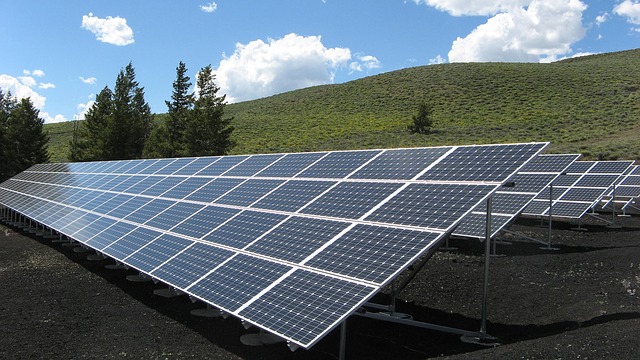Reducing Carbon Emissions is Good for Business
It’s time for all of us to examine the roles that our homes and businesses play in the growing climate change crisis. Our future doesn’t have to be bleak if we take action now.
The first step to reducing emissions is knowing how much carbon your business emits. Find out your emissions with this handy business carbon calculator from the United States Environmental Protection Agency.

Knowledge About Our Climate Empowers Us
Bringing about change begins with knowledge. It’s a fact that more than half of Americans rarely talk about climate change. Frequently this happens because people don’t understand enough about the problem. Or they are overwhelmed by what they perceive to be the the scope of the problem.
This can be remedied by learning and having conversations about the problem. Through education your business can promote employee dialogue about your companies sustainability practices and policies.
Engage your customers and make them aware of the policies you use to reduce carbon emissions. In this article I will discuss the seven steps that every business can take to reduce their Carbon emissions.
Remember the Three R’s
I imagine that most of us have heard the phrase “reduce, reuse, recycle” used to refer to the environment. It’s here that any business new to the green movement will find its starting point.
Embrace the Three R’s and apply them to every facet of your business. These terms apply to food, packaging, to office supplies, to operations, and supply chains, every action that a business takes.

We should always opt for reducing and reusing first, as these practices skim the excess. When there’s no reusable alternative or reusing simply doesn’t work for your business, initiate a recycling program in your business.
There are some items that municipal recycling programs do not accept. You can partner with organizations like TerraCycle for the items not accepted by your waste company. Doing this will allow you to recycle many ot the things that would otherwise end up in a landfill.
Reduce Your Food Waste
Food waste occurs at every stage of the food supply chain. According to the U.N. Food and Agriculture Organization, 30 percent of food is wasted globally across the supply chain, contributing 8 percent of total global greenhouse gas emissions. Food recovery is an environmental crisis in addition to being a business one.

Your business doesn’t have to be a restaurant or grocery store to reduce food waste. A business using a caterer that sources from local farms will reduce their food waste. Purchasing from businesses that support local farmers and the community, you indirectly reduce food waste by minimizing transportation in the food system.
If you create a business compost program it will recycle food waste into fertilizer. If you can’t create an in-business program, findacomposter.com lists service options available in your area.
Support Sustainability Using Your Business Voice
Did you know your business has a voice? Your customers are eager to engage with and purchase from a business that aligns with their values. To illustrate how effective this is, when President Trump pulled out of the Paris Climate Agreement, over 2,000 businesses and investors pledged to continue working towards the accord standards.

Backing policies that reflect your values is good for your bottom line:
- 87% of customers will purchase from a company advocating for an issue they care about
- 82% of US Fortune employees want to work for the CEO of a company vocal about social issues
These policies could include anything among the spectrums of human rights, climate change, cultural values, and public health, just to name a few.
Invest in Renewable Energy
The solar and wind industries are two fastest-growing job segments in the U.S.A.. This is due to the growing interest in and adoption of renewable energy sources. We have also seen electric vehicle production grow to record levels.
Even utility companies are incorporating renewables in their portfolios. More and more companies are investing in renewable energy for their business operations. Companies are looking at these as part of their long-term investment strategy.

Conventional workplaces on the power grid, may have a significant challenge. In these cases, reduce your consumption by using high-efficiency lighting and powering off all electronics when not in use. If you want to proactive with clean energy, purchasing Renewable Energy Certificates (RECs) demonstrates your office’s commitment to clean energy.
You may also find it easier to convert your home office to on-site renewables. Depending on where you live, your local government may also offer subsidies and rebates.
Use Green Refrigerants and Appliances
Both refrigerators and air conditioning units release harmful chemicals and greenhouse gases that damage the atmosphere. The original culprits, chlorofluorocarbons (CFCs) and hydrochlorofluorocarbons (HCFCs), were responsible for tearing a hole in the ozone layer in the 1980s.
While these chemicals are not in use anymore, their replacement hydrofluorocarbons (HFCs) are still 1,000 to 9,000 times more potent than CO2 in terms of climate impact. Luckily, green tech has cleaner, friendlier alternatives: GreenFreeze fridges by Greenpeace and smart refrigerators.

Introduced in the 1990s, GreenFreeze refrigerators are used globally and stay cool using naturally occurring hydrocarbons that are far less potent than HFCs and don’t break down into toxins. Unfortunately, these refrigerators are not widely available in the US since the EPA only allowed manufacturers to sell in the states starting in 2011.
Smart refrigerators may be a more accessible alternative. With the purpose of reducing your electricity bill, smart refrigerators are designed to cool around your opening habits. When your refrigerator has reached the end of its life, choose to dispose or recycle it responsibly with RAD.
Use Sustainable Web Hosting Services
Hosting services are the invisible fossil fuel consumers. Unless you host your site yourself, your website likely lives on a data server in a warehouse powered by fossil fuels. Data servers consume huge amounts of energy because they need to be powered on and kept cool at all times. Sustainable hosting services purchase Renewable Energy Certificates to claim their renewable energy usage.

The Green Business Network is home to several certified sustainable hosting members like CanvasHost and Sustainable Hosting. By negating the environmental and social costs of fossil fuel-powered hosting, our members are leaders in green computer services.
Utilize Fairtrade
The least carbon-intensive option is the one that has traveled the fewest miles. However, the reality is that international trade will not stop for climate change. Sustainable solutions in globalization are imperative to reducing your business’s carbon footprint. This is where utilizing fairtrade can help.

Smallholder farmers in developing countries are disproportionately affected by climate change. Fairtrade organizations aim to equip farmers with the tools to adapt to and combat climate change, such as developing nutrient-rich soils and investing in reforestation projects. These projects not only sequester carbon but foster environmentally sustainable agricultural production as well. Read more on Fairtrade and Sustainability here.
Fund Emissions Reduction Projects
When you purchase carbon offsets, you are funding projects to reduce greenhouse gas emissions. Carbon offsets are a form of trade acting as a balancing agent used to negate your carbon emissions. Keep in mind that carbon offsets don’t reduce the amount of carbon in the atmosphere.
TerraPass has a carbon calculator that you can use to determine the carbon emissions of your activities and then the monetary value of those emissions. Your carbon offset purchases may be tax-deductible, depending on what company you purchase your offsets from. It’s a good idea to include your offset costs in your annual budget.

While carbon offsets are controversial, they can be a convenient last resort when you’ve exhausted other options. If you purchase your offsets from a company that is transparent about their projects, carbon offsets may be a useful tool towards carbon neutrality.
Become A Catalyst Against Climate Change
Embracing being a green business requires you to take traditional practices out of their linear state and instead thinking circular. Consider how every action affects your workers, customers, planet, and comes back to your business.
The single-bottom line business model is not enough anymore. The newest generation of your customers, milennials represent $2.45 trillion in spending power. Statistics show that 70% of milennials are willing to spend more with brands that share their values.
To make a stand against climate change, business leaders must step up now to reduce carbon emissions. Taking a stand will only help your business and the planet in the long run.
Calculate Your Carbon Footprint
If you would like to calculate your Carbon Footprint, follow the link to the free carbon footprint calculator of the United States Environmental Protection Agency.








